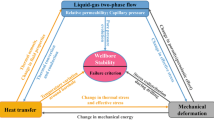Abstract
The freezing–thawing damage of rock mass involves the coupling of temperature field, seepage field and stress field (THM) at low temperature. Based on water/ice phase transition theory and energy conservation principle, the expression of freezing rate is obtained. According to the law of conservation of mass, the law of conservation of energy and the principle of static equilibrium, the coupling governing equation of THM of fractured rock mass under freezing condition is obtained by using the dual-porosity medium theory. An example of underground LNG storage in low temperature condition is used to verify the proposed THM coupling model. The surrounding rock is regarded as a system composed of rock blocks and fracture media, and the equivalent thermal expansion coefficient method is used to simulate the frost heaving effect of ice-filled fractures. The influence of freezing process on the permeability coefficient of rock mass is considered in simulation. The distribution of temperature, stress and pore pressure under THM coupling condition at low temperature is studied.










Similar content being viewed by others
Data Availability
Enquiries about data availability should be directed to the authors.
Change history
12 January 2023
A Correction to this paper has been published: https://doi.org/10.1007/s10706-022-02366-5
References
Biot M (1941) General theory of three-dimensional consolidation. J Appl Phys 12:155–164
Cha SS, Lee JY, Lee DH, Amantini E, Lee KK (2006) Engineering characterization of hydraulic properties in a pilot rock cavern for underground. Eng Geol 84(3):229–243
Chen Y, Zhou C, Jing L (2009) Modeling coupled THM processes of geological porous media with multiphase flow: theory and validation against laboratory and field scale experiments. Comput Geotech 36:308–1329
Esmaeili S, Sarma H, Harding T (2019) Review of the effect of temperature on oil-water relative permeability in porous rocks of oil reservoirs. Fuel 237:91–116
Glamheden R, Lindblom U (2002) Thermal and mechanical behaviour of refrigerated caverns in hard rock. Tunn Undergr Space Technol 17:341–353
Hallet B, Walder J, Stubbs C (1991) Weathering by segregation ice growth in microcracks at sustained subzero temperatures: verification from an experimental study using acoustic emissions. Permafr Periglac Process 2:283–300
Hemmatia S, Gatmiric B, Cui Y, Vincent M (2012) Thermo-hydro-mechanical modelling of soil settlements induced by soil–vegetation–atmosphere interactions. Eng Geol 139–140:1–16
Ji Y, Cheng J, Liu J et al (2011) A simulation of casing damage considering THM coupling. Pet Sci Technol 29:977–987
Jiao Y, Wu K, Zou J, Zheng F, Zhang X, Wang C, Li X, Zhang C (2021a) On the strong earthquakes induced by deep coal mining under thick strata-a case study. Geomech Geophys Geo-Energy Geo-Resour 7:97
Jiao Y, Wu K, Zou J et al (2021b) On the strong tremors related by deep coal mining under thick strata-a case study. Geomech Geophys Geo-Energy Geo-Resour 7(4):1–11
Kang Y, Liu Q, Huang S (2013) A fully coupled thermo-hydro-mechanical model for rock mass under freezing/thawing condition. Cold Reg Sci Technol 95:19–26
Konrad J, Morgenstem N (1982) Effects of applied pressure on freezing soils. Can Geotech J 19:494–505
Lai YM, Li JB, Li QZ (2012) Study on damage statistical constitutive model and stochastic simulation for warm ice-rich frozen silt. Cold Reg Sci Technol 71:102–110
Li L, Tang C, Wang S, Yu J (2013) A coupled thermo-hydrologic-mechanical damage model and associated application in a stability analysis on a rock pillar. Tunn Undergr Space Technol 34:38–53
Liu Z, Chen J, Jin L, Zhang Y, Lei C (2013) Roadbed temperature study based on earth atmosphere coupled system in permafrost regions of the Qinghai–Tibet Plateau. Cold Reg Sci Technol 86:167–176
Loch JPG, Kay BD (1978) Water redistribution in partially frozen saturated silt under several temperature gradients and overburden loads. Soil Sci Soc Am J 42(3):400–406
Miller RD (1972) Freezing and heaving of saturated and unsaturated soils. Highway Res Rec 39(1):1–11
Philip J, De Veries D (1957) Moisture movement in porous material under temperature gradient. Trans Am Geophys Union 38:222–232
Tan X, Chen W, Tian H, Cao J (2011) Water flow and heat transport including ice/water phase change in porous media: numerical simulation and application. Cold Reg Sci Technol 68:74–84
Tang Z, Sun M (2022) Thermodynamic properties of marble with varying slenderness ratios. Int J Geomech 22(7):04022088
Tang Z, Wu Z, Zou J (2022) Appraisal of the number of asperity peaks, their radii and heights for three-dimensional rock fracture. Int J Rock Mech Min Sci 153:105080
Tang Z, Zhang Q, Peng J (2020) Effect of thermal treatment on the basic friction angle of rock joint. Rock Mech Rock Eng 53:1973–1990
Yang G, Zhou C, Tian Y (2006) Numerical simulation and analysis of moistureheat coupling for soft rock tunnel in cold regions. Rock Soil Mechan 27:1258–1262 (in Chinese)
Zhang G, Xia C, Sun M, Zou Y, Xiao S (2013) A new model and analytical solution for the heat conduction of tunnel lining ground heat exchangers. Cold Reg Sci Technol 88:59–66
Zou J, Hu X, Jiao YY, Chen W, Wang J, Shen L, Tang Z, Gong S (2022) Dynamic mechanical behaviors of rock's joints quantified by repeated impact loading experiments with digital imagery. Rock Mech Rock Eng
Acknowledgements
This work was supported by the National Key Research and Development projects of China (Grant No. 2021YFB4001405). This support is gratefully acknowledged.
Author information
Authors and Affiliations
Corresponding author
Ethics declarations
Conflict of interest
The authors have not disclosed any conflict of interest.
Additional information
Publisher's Note
Springer Nature remains neutral with regard to jurisdictional claims in published maps and institutional affiliations.
Rights and permissions
Springer Nature or its licensor (e.g. a society or other partner) holds exclusive rights to this article under a publishing agreement with the author(s) or other rightsholder(s); author self-archiving of the accepted manuscript version of this article is solely governed by the terms of such publishing agreement and applicable law.
About this article
Cite this article
Zhang, C., Duan, P., Xiao, H. et al. A Fully Thermo-Hydro-Mechanical Coupling Simulation at Low Temperature in Underground LNG Storage. Geotech Geol Eng 41, 1019–1029 (2023). https://doi.org/10.1007/s10706-022-02320-5
Received:
Accepted:
Published:
Issue Date:
DOI: https://doi.org/10.1007/s10706-022-02320-5




